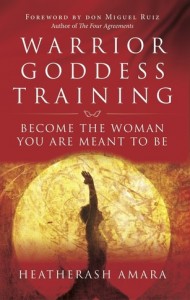When you think of the two words ‘warrior’ and ‘Goddess’, what image comes to mind? Possibly Bast, Athena, Durga, Freya or Kali- battle ready, sword wielding, bloody tongued, vanquishing enemies. What if being both means standing your ground, while simultaneously being open to life as it presents itself? That is the essence of the sophomore release by HeatherAsh Amara, entitled Warrior Goddess Training- Become the Woman You Were Meant to Be. In a conversational sister to sister style, Amara shares openly her own joys and challenges, with an unabashed willingness to bare her soul. It makes her and the book all the more approachable and the work impactful.
Part of the Toltec lineage of don Miguel Ruiz (author of the classic Four Agreements), she mines treasures from deep spiritual ideology and makes them accessible. Very much at home with indigenous teachings, as well as modern psychological concepts, blended with Earth based religion and Divine Feminine wisdom, Amara begins the book by defining terms.
She explains that “Warrior energy is a combination of focus, dedication, purpose and determination., ” and that “Goddess energy is our creative flow; unconditional love, pleasure, passion and wisdom.” In combination, we are a force to be reckoned with in positive ways. Acknowledging throughout the pages that many women are not at home in our own skin and are sometimes as self loathing as we are loving of others, she invites exploration of what is at the core of that. A mini glossary with definitions of words like ‘attachment’, ‘agreement’ and ‘Earth Goddess Spirituality’ set the stage for what is to follow.
She references the heroine’s journey on which we all embark; more than myth, instead an opportunity to step out of our comfort zones as we are called to adventure, face ‘dragons’, go deep into the shadow realms, emerging with a hard won prize and returning to share the treasure with others, enriching our lives and theirs. Amara is enthusiastic about encouraging her readers to disavow their self deprecation and instead embrace the true beauty within that need not be measured by external standards and definition.
One of the most powerful concepts she presents has to do with the stories we tell ourselves about our lives that we believe to be gospel. Having grown up in a family that traveled a great deal, related to her father’s career, she would begin to settle in , start to make friends in the face of seeing herself as rather introverted and then they would move and she would be the ‘new kid’ again. What she told herself was that this was a negative thing that impinged on her ability to step out and comfortably meet new people as an adult. When she reframed the story to indicate that it was a positive series of events that afforded her the ability to experience new countries and connect with people of varying lifestyles and cultures, she felt an uplift. She then asked herself which story was true. Both and neither.
Personal inquiry and experiential exercises are richly scattered throughout the pages, including taking baby steps to make changes, learning about coping skills, awareness of the messages we give ourselves, as well as observation of the outcome of our actions. At the end of each of the ten chapters, Amara invites readers to recognize the gifts inherent in the concepts presented and ways of exploring them.
The book closes with a quote by playwright Ntozake Shange who created for colored girls who have considered suicide/when the rainbow is enuf; “I found God in myself and I loved her….I loved her fiercely.” That is the core truth of this self-love bath of a book.

